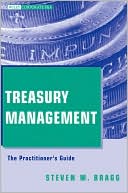Treasury Management: The Practitioner's Guide (Wiley Corporate F&A Series)
Search in google:
With a broad range of responsibilities in the modern corporation, ranging from cash management to the proper movement of potentially large amounts of funds and the construction of hedges, the treasurer's duties require the integration of a comprehensive set of controls into a broad-based pro-cedural framework. Written by renowned accounting expert Steven Bragg, Treasury Management: The Practitioner's Guide shortens the treasurer's learning curve for all aspects of the position with authoritative coverage of the general categories of cash management, financing, risk management, and treasury systems. Addressing the treasury function from every angle, this invaluable guide: Addresses the various methods by which a company transfers cash, both on paper and by electronic means Shows how to create a cash forecast and monitor its accuracy Covers several methods for aggregating cash from a multitude of locations Explores the components of working capital and how they may be altered, thereby impacting cash flow planning Looks at what the treasurer does to raise debt and equity, as well as how to invest funds Includes discussions of the various kinds of debt and key characteristics of each one, how to deal with credit rating agencies, and the intricacies of equity offerings Discusses investments including investment criteria, types of available investments, and investment and risk-reduction strategies Considers an increasingly important aspect of the treasurer's responsibilities: risk management Describes the technology that drives many treasury transactions Filled with extensive supporting examples, Treasury Management: The Practitioner's Guide is the ideal sourcebook for the mechanics of how to run all aspects of the modern treasury department.
Preface ixAbout the Author xiPart 1 Cash Management 1Chapter 1 Treasury Department 3Role of the Treasury Department 3Treasury Controls 6Treasurer Job Description 7Position of Treasury within the Corporate Structure 7Treasury Centralization 8Treasury Compensation 10Bank Relations 10Treasury Outsourcing 13Summary 18Chapter 2 Cash Transfer Methods 21Check Payments 22Wire Transfers 27ACH Payments 28Procurement Cards 31Cash Payments 32Fees for Cash Transfers 32Summary of Cash Transfer Methods 32Cash Transfer Controls 34Cash Transfer Procedures 43Summary 48Chapter 3 Cash Forecasting 49Cash Forecasting Model 49Information Sources for the Cash Forecast 53Measuring Cash Forecast Accuracy 54Cash Forecasting Automation 55Bullwhip Effect 57Business Cycle Forecasting 58Cash Forecasting Controls 60Cash Forecasting Policies 62Cash Forecasting Procedure 62Summary 62Chapter 4 Cash Concentration 67Benefits of Cash Concentration 67Cash Concentration Strategies 69Pooling Concepts 70Physical Sweeping 70Notional Pooling 73Comparison of Account Sweeping and Notional Pooling 74Nonpooling Situations 75Bank Overlay Structure 75Cash Concentration Controls 76Cash Concentration Policies 78Cash Concentration Procedures 79Summary 81Chapter 5 Working Capital Management 83Working Capital Variability 83Cash Management 85Credit Management 85Receivables Management 87Inventory Management 88Working Capital Metrics 95Summary 102Part 2 Financing 103Chapter 6 Debt Management 105Types of Debt 105Credit-Rating Agencies 116Accounting for Debt 118Debt-Related Controls 130Debt-Related Policies 134Debt-Related Procedures 135Summary 136Chapter 7 Equity Management 141Stock Registration 141Exemptions from Stock Registration 147Accounting for Stock Sales 150Equity-Related Controls 152Equity-Related Policies 154Equity-Related Procedures 156Summary 163Chapter 8 Investment Management 165Investment Criteria 165Investment Options 166Investment Strategies 169Outsourced Investment Management 172Risk-Reduction Strategies 173Accounting for Investments 174Investment Journal Entries 182Investment Reporting 188Investment Management Controls 188Investment Management Policies 191Investment Management Procedures 195Summary 199Part 3 Risk Management 205Chapter 9 Foreign Exchange Risk Management 207Foreign Exchange Quote Terminology 207The Nature of Foreign Exchange Risk 208Data Collection for Foreign Exchange Risk Management 209Foreign Exchange Hedging Strategies 210Hedge Accounting 223Foreign Exchange Hedge Controls 232Foreign Exchange Hedge Policies 234Record Keeping for Foreign Exchange Hedging Activities 235Foreign Exchange Hedge Procedures 236Summary 238Chapter 10 Interest Risk Management 239Interest Risk Management Objectives 239Interest Risk Management Strategies 240Accounting for Interest Risk Management Activities 253Interest Risk Management Policies 266Record Keeping for Interest Rate Risk Management 267Interest Risk Management Procedures 267Summary 267Part 4 Treasury Systems 271Chapter 11 Clearing and Settlement Systems 273Characteristics of Clearing and Settlement Systems 273Overview of the Clearing and Settlement Process 273Fedwire 275Automated Clearing House (ACH) System 275Clearing House Interbank Payments System (CHIPS) 277Check Clearing 278The Continuous Link Settlement (CLS) System 280Summary 281Chapter 12 Treasury Systems 283Treasurer's Technology Needs 283Treasury Management System 285SWIFT Connectivity 287Summary 288Index 289








